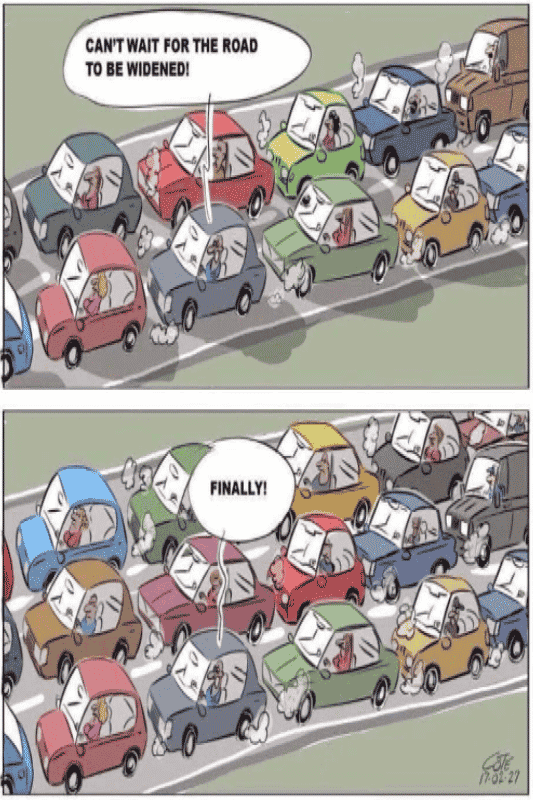
Pakistan Institute of Development Economics
- Home
Our Portals
MenuMenuMenuMenuMenuMenuMenu - ResearchMenuMenuMenuMenuMenuMenuMenu
- Discourse
- The PDR
- Our Researchers
- Academics
- Degree Verification
- Thesis Portal
- Our Portals

Roads – Wider Roads – Corridors – Signal-Free Highway and Then A Tale of Srinagar Highway
Where does the mantra of constructing roads lead – nowhere other than to more roads and wider roads. On 8th February 2022, the Capital Development Authority (CDA) announced a plan to make 3 more either interchanges or underpasses on Srinagar Highway at G-9, G-10 and G-11 signals because of traffic congestion at these intersections (Dawn, 2022). It is to be noted that Srinagar Highway is a two-way 5 lane road which by all means is already stretched to its limits. Moreover, going by the same numbers as in the case of Rawal Chowk and 7th Avenue project, the aforementioned intervention will cost around PKR 3 billion each. If an underpass is to be constructed then it would cost around PKR 700-800 million each (calculations based on earlier Tenders of 7th Avenue Interchange & G-7 underpass; (Abbasi, 2021; Choudhry, 2020; Tribune, 2020).
With the addition of more interchanges or underpasses, will congestion on the roads be tackled; the simple answer is: No!
It can reduce the traffic occupancy on the road for some years to come, but what then? Will we then again widen the road or come up with some other cure to the ailing disease of rising traffic congestion. Before going further – let’s be clear: personal ridership, a major occupant of our roads, is bad for any city in the world and we should discourage it or it will make our cities unlivable.

By definition a signal-free highway, the Srinagar highway is already a signal-free corridor. Removing a couple of intersections that exist on the highway, it will then become a runway rather than a highway, which of course is not the purpose of the said infrastructure. Apart from this, the very concept of a freeway is becoming irrelevant around the world. It is obsolete, as it creates more problems than the one we would it to cater for, which also is really not a problem rather a misconception.
The most important concept to look at peak hour congestion is the Principle of Triple Convergence. In layman terms it is very simple i.e. assume a road is heavily congested every day for at least 20-30 minutes. Now assume we magically double the capacity of that road overnight. The next day the same number of cars will utilize the doubled capacity and enjoy more road space. Other drivers will hear news of the uncongested road in peak hours and shift back into that peak period. Other drivers will also come to use this road who have been lately utilizing alternative routes. Within a short time, this triple convergence upon the expanded road during peak hours would make the road as congested as before its expansion (Downs, 2005).
Studies have already shown that widening roads will lead to more congestion and it is classically proven by Braess Paradox (1968) that adding a lane to a road further worsen the condition of traffic (Braess, 2005). Thus making Srinagar highway signal-free end-to-end will only attract more traffic from the nearby arteries, nothing else. Congestion will increase, rather than decreasing as a result.
Instead of widening roads, building more intersections or a signal-free highway, we need a more sustainable solution. The focus must shift to options of collective mobility rather than incentivizing single-use vehicles. For example, buses greatly expand the capacity of public transit. The average occupancy rate of a single-use vehicle such as a car is 1.5 persons (CSS, 2019). Going by this estimation, moving 50 individuals will require about 33 cars, compared to one bus. Thus we can decrease congestion by thirty threefold.
According to a recent news report, the Capital Development Authority (CDA) is launching a new bus system in the city with a fleet of 29 buses (The News, 2022). Instead of underpasses and flyovers which inefficiently consume billions of rupees from the national exchequer, the authority must look elsewhere. Increasing the scope of its new bus project is one option. Instead of 29 buses, it should focus on deploying 100 or even 200 buses. It must design a proper ecosystem for collective or shared mobility in the city.
Moreover, rom an environmental point of view, collective mobility has a lower environmental footprint as compared to single-use vehicles. Buses emit far less greenhouse gas emissions than single occupant vehicles (Hussain, 2019). Similarly, we require more strategic/soft approaches to mitigate the increasing problem of congestion in the city. One example is the recent intervention by ICT administration is staggering work hours for schools. They have implemented this across different sectors, significantly easing congestion in peak hours. Lastly, the authority must also look into road pricing and how they can implement it in Islamabad. Road pricing is an essential mechanism for coping with excessive demand for road space.
Editor’s Note:
Aqeel Chaudhry, Syed Saddam Haider and Adnan Saqib contributed to this blog.
About the Authors:
Aqeel Chaudhry is a Lecturer @ PIDE
Syed Saddam Haider and Adnan Saqib are Research Assistants in PIDE’s Centre for Urban Research.
Download full PDF


